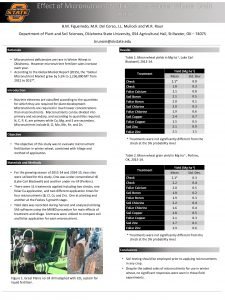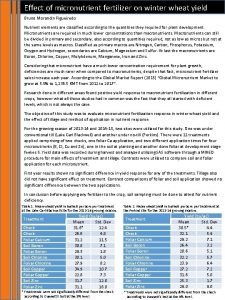Effect of Micronutrient Fertilizers on Winter Wheat Grain

- Slides: 1

Effect of Micronutrient Fertilizers on Winter Wheat Grain Yield B. M. Figueiredo, M. R. Del Corso, J. L. Mullock and W. R. Raun Department of Plant and Soil Sciences, Oklahoma State University, 054 Agricultural Hall, Stillwater, OK – 74075 brunom@okstate. edu Rationale • Micronutrient deficiencies are rare in Winter Wheat in Oklahoma. However micronutrient fertilizer sales increase each year. • According to the Global Market Report (2015), the “Global Micronutrient Market grew by 5. 5% to 1, 236, 000 MT from 2012 to 2017”. Introduction • Nutrient elements are classified according to the quantities for which they are required for plant development. Micronutrients are required in much lower concentrations than macronutrients. Macronutrients can be divided into primary and secondary, and according to quantities required. N, C, P, K, are primary while Ca, Mg, and S are secondary. Micronutrients include B, Cl, Mo, Mn, Fe, and Zn. Objective • The objective of this study was to evaluate micronutrient fertilization in winter wheat, combined with tillage and method of application. Materials and Methods • For the growing season of 2013 -14 and 2014 -15, two sites were utilized for this study. One was under conventional till (Lake Carl Blackwell) and another under no-till (Perkins). • There were 11 treatments applied including two checks, one foliar Ca application, and two different application times for four micronutrients (B, Cl, Cu and Zn). One at planting and another at the Feekes 5 growth stage. • Yield data was recorded during harvest and analyzed utilizing SAS software using the MIXED procedure for main effects of treatment and tillage. Contrasts were utilized to compare soil and foliar application for each micronutrient. Results Table 1. Mean wheat yields in Mg ha-1, Lake Carl Blackwell, 2013 -14. Treatment Check Foliar Calcium Soil Boron Foliar Boron Soil Chlorine Foliar Chlorine Soil Copper Foliar Copper Soil Zinc Foliar Zinc Yield (Mg ha-1) Mean Std. Dev 2. 1* 0. 8 1. 8 0. 3 2. 1 0. 8 2. 1 0. 5 2. 0 0. 1 2. 0 0. 3 1. 9 0. 6 2. 4 0. 7 1. 5 0. 5 2. 1 0. 9 2. 1 1. 1 * Treatments were not significantly different from the check at the 5% probability level. Table 2. Mean wheat grain yield in Mg ha-1 , Perkins, OK, 2013 -14. Treatment Check Foliar Calcium Soil Boron Foliar Boron Soil Chlorine Foliar Chlorine Soil Copper Foliar Copper Soil Zinc Foliar Zinc Yield (Mg ha-1) Mean Std. Dev. 2. 1* 0. 3 2. 2 0. 4 2. 0 0. 5 1. 8 0. 2 1. 9 0. 3 2. 2 0. 4 1. 6 0. 4 1. 8 0. 5 2. 1 0. 3 1. 7 0. 1 1. 9 0. 6 * Treatments were not significantly different from the check at the 5% probability level. Conclusions Figure 1. Great Plains no-till drill adapted with CO 2 system for liquid fertilizer. • Soil testing should be employed prior to applying micronutrients in any crop. • Despite the added sales of micronutrients for use in winter wheat, no significant responses were seen in these field experiments.

